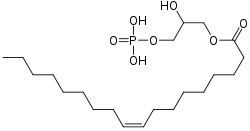Lysophosphatidic acid
 | |
| Names | |
|---|---|
| IUPAC name
(2-hydroxy-3-phosphonooxypropyl) (Z)-octadec-9-enoate | |
| Other names
LPA | |
| Identifiers | |
3D model (JSmol) |
|
| ChEMBL | |
| ChemSpider | |
| ECHA InfoCard | 100.040.631 |
| EC Number | 244-710-0 |
| MeSH | lysophosphatidic+acid |
PubChem CID |
|
| |
| |
| Properties | |
| C21H41O7P | |
| Molar mass | 436.52 g/mol |
Except where otherwise noted, data are given for materials in their standard state (at 25 °C [77 °F], 100 kPa). | |
| Infobox references | |
Lysophosphatidic acid (LPA) is a phospholipid derivative that can act as a signaling molecule.[1]
Function
LPA acts as a potent mitogen due to its activation of three high-affinity G-protein-coupled receptors called LPAR1, LPAR2, and LPAR3 (also known as EDG2, EDG4, and EDG7). Additional, newly identified LPA receptors include LPAR4 (P2RY9,GPR23), LPAR5 (GPR92) and LPAR6 (P2RY5,GPR87).
Clinical significance
Because of its ability to stimulate cell proliferation, aberrant LPA-signaling has been linked to cancer in numerous ways. Dysregulation of autotaxin or the LPA receptors can lead to hyperproliferation, which may contribute to oncogenesis and metastasis.[2]
LPA may be the cause of pruritus (itching) in individuals with cholestatic (impaired bile flow) diseases.
GTPase activation
Downstream of LPA receptor activation, the small GTPase Rho can be activated, subsequently activating Rho kinase. This can lead to the formation of stress fibers and cell migration through the inhibition of myosin light-chain phosphatase.
Metabolism
There are a number of potential routes to its biosynthesis, but the most well-characterized is by the action of a lysophospholipase D called autotaxin, which removes the choline group from lysophosphatidylcholine.
Lysophosphatidic acid is also an intermediate in the synthesis of phosphatidic acid.

See also
References
- ↑ Reginald Garrett; Charles M. Grisham (28 December 2008). Biochemistry. Cengage Learning. pp. 235–. ISBN 978-0-495-10935-8. Retrieved 20 December 2010.
- ↑ Benesch, MG; Ko, YM; McMullen, TP; Brindley, DN (2014). "Autotaxin in the crosshairs: taking aim at cancer and other inflammatory conditions". FEBS Letters. 588 (16): 2712–27. doi:10.1016/j.febslet.2014.02.009. PMID 24560789.
Further reading
- Kremer, Andreas E.; Martens, Job J.W.W.; Kulik, Wim; Ruëff, Franziska; Kuiper, Edith M.M.; Van Buuren, Henk R.; Van Erpecum, Karel J.; Kondrackiene, Jurate; et al. (2010). "Lysophosphatidic Acid is a Potential Mediator of Cholestatic Pruritus". Gastroenterology. 139 (3): 1008–18, 1018.e1. doi:10.1053/j.gastro.2010.05.009. PMID 20546739.
- Moolenaar, Wouter H. (1995). "Lysophosphatidic Acid, a Multifunctional Phospholipid Messenger". The Journal of Biological Chemistry. 270 (22): 12949–52. doi:10.1074/jbc.270.22.12949. PMID 7768880.
- Mills, Gordon B.; Moolenaar, Wouter H. (2003). "The emerging role of lysophosphatidic acid in cancer". Nature Reviews Cancer. 3 (8): 582–91. doi:10.1038/nrc1143. PMID 12894246.
- Panupinthu, N; Lee, H Y; Mills, G B (2010). "Lysophosphatidic acid production and action: Critical new players in breast cancer initiation and progression". British Journal of Cancer. 102 (6): 941–6. doi:10.1038/sj.bjc.6605588. PMC 2844037. PMID 20234370.
- Park, S Y; Jeong, K J; Panupinthu, N; Yu, S; Lee, J; Han, J W; Kim, J M; Lee, J-S; et al. (2010). "Lysophosphatidic acid augments human hepatocellular carcinoma cell invasion through LPA1 receptor and MMP-9 expression". Oncogene. 30 (11): 1351–9. doi:10.1038/onc.2010.517. PMID 21102517.